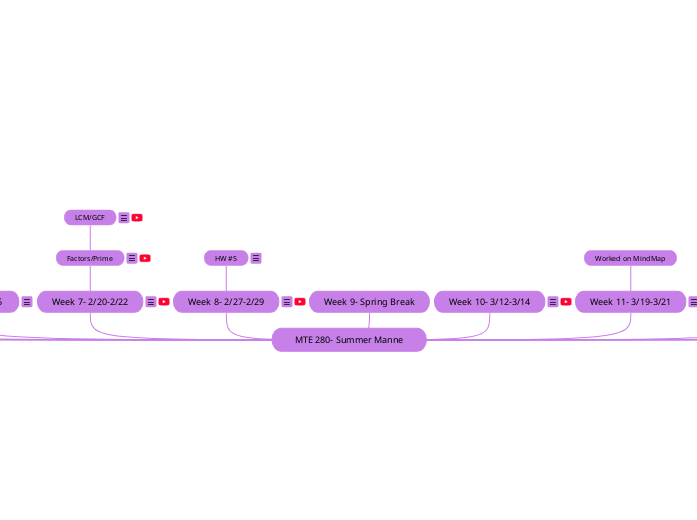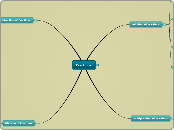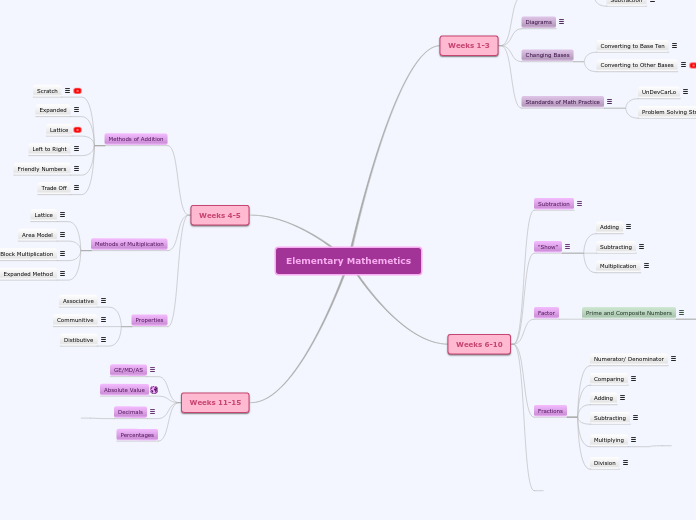MTE 280- Summer Manne
Week 16- 4/23-4/25
HW #10 & Evaluation
Week 15- 4/16-4/18
Integers: Positive and Negative Numbers
Number Line
"chip method"
"zero pair"
Addition:
5+1=6
5+-1= 4
-5+-1= -6
Subtraction:
5-+1= 4
-5--1= -4
-5-+1= -6
Multiplication/Division
2x3= 6 = 2 groups of 3
3x-2= -6 = 3 groups of -2
-3x-2 = opposite
-6 | 6
Week 14- 4/9-4/11
Percentages
3/11 = 0.27 repeating
5/6 = 0.83 repeating
5/9 = 0.5 repeating
Practice Problems:
a. 8 = nx22
n = 8/22
= 0.36
= 36%
b. 0.08x22 = n
n = 1.76
c. 0.08 x n = 22
n = 22/0.08
= 275
HW #8
7/8 = 0.875
5/3 = 1.6 repeating
5/6 = 0.83 repeating = 83%
5/9 = 0.5 repeating = 56%
a. 24 = n x 180
= 0.13
= 13%
b. 0.30 x n = 21
= 70
Week 13- 4/2-4/4
Worked on graphing paper in class
Adding & Subtracting Decimals
3.23
+ 1.50
__________
4.73
4.39
+ 2.37
__________
6.76
3.89
- 1.52
_________
2.37
5.00
- 2.37
_________
2.63
Multiplying Decimals
3.2
x 2.2
_________
6.4
6 4. 0
_________
7. 0 4
4.3
x 2
________
8. 6
369.63/3
= 123.21
369.63/31
= 119.2
Week 12- 3/26-3/28
Test #2
Test Review
Week 11- 3/19-3/21
Practice Problems:
- 3/8
- 2/7
Worked on MindMap
Week 10- 3/12-3/14
1.
Jim=1/4 = 3/12 = 12 bars
Ken-1/3 = 4/12 = 16 bars
Len-1/3 = 4/12 = 16 bars
Max-4 Bars = 1/12 = 4 bars
2.
Len- 4 bars
Ken- 6 bars
Jim-6 bars
Max- 8 bars
Total = 24 bars
HW #6
Week 9- Spring Break
Week 8- 2/27-2/29
Fractions:
- Part-Whole
- Quotient
- Ratio
11 boys 9/11 = ratio
9 girls
___________
20 students
boys/whole = 11/20 = ratio & fraction
Models (manipulatives)
- Area (filled in boxes)
- Length (number line)
- Set (groups of things)
3/3 = 1
4/4 = 1
2/2 = 1
FRACTIONAL PARTS ARE EQUIVALENT PARTS
8a^3b^2c
___________
24a^2bc = ab/3
HW #5
1. No, because in order for a number to be divisible by 5, it has to end in a 0 or a 5. In order for a number to be divisible by 10, it has to end in a 0. So if it does not end in a 0, it is not divisible by 5, or by 10.
2. Yes, a number that is not divisible by 10 can still be divisible by 5. This is because if it were divisible by 10, it would have to end in a 0. Numbers that are divisible by 5 can end in a 0 or a 5.
3. No, two numbers cannot have a "greatest common multiple" because the greatest common multiple of any two numbers is always infinity since any multiple of both numbers would be a common multiple.
4. I would say that she is wrong, her prime numbers will be the same at Tom’s. This is because it doesn’t matter what factors you start with, as long as it equals the same number. 5. You have to find the LCM in order to find the first caller to receive both. The LCM (12,13,20) = 780, so the first caller to get a coupon and a ticket is the 780th caller
Week 7- 2/20-2/22
Number Theory:
-types of numbers
-divisibility rules
-factors-multiples
___________________
ready for fractions
Divisibility Rules:
by 2: 0, 2, 4, 6. 8
by 5: 0, 5
by 10: 0
by 3: sum of digits is divided by 3
by 9: sum of digits is divided by 1
by 4: last 2 digits
by 8: last 3 digits
divided by both 2 & 3
double last digit
take remaining #
subtract from it the # doubled
chop off last 2 digits
take remaining # and add # we chopped off
10 is divisible by 2
10 is divisible by 5
5 is a factor of 10
2 is a factor of 10
10 is a multiple of 5
10 is a multiple of 2
5 is a divisor of 10
2 is a divisor of 10
Factors/Prime
Factors:
28: 1, 2, 4, 7, 14, 28
36: 1, 2, 3, 4, 9, 12, 18, 36
42: 1, 2, 3, 6, 7, 14, 21, 42
60: 1, 2, 3, 4, 5, 6, 10 12, 15, 20, 30, 60
91: 1, 7, 13, 91
Prime:
3: 1, 3
2: 1, 2
13: 1, 13
11: 1, 11
1: NO- only 1 factor
0: NO- additive identity element
LCM/GCF
LCM: least common factor
List Method:
24: 1, 2, 3, 4, 6, 8, 12, 24 GCF = 12
36: 1, 2, 3, 4, 6, 9, 12, 18, 36 GCF (24,36) = 12
GCF:
25/100 = 5/20
25/100 = 1/4
Prime Factorization Method:
24 = 2x2x2x3
36 = 2x2x3x3
GCF (24,36) = 2x2x3 = 12
LCM (24,36) = 12x2x3 = 72
List:
24: 1, 2, 3, 4, 6, 8, 12, 24
30: 1, 2, 3, 5, 6, 10, 15, 30
24, 48, 72, 96, 120
30, 60, 90, 120
GCF (24,30) = 6
LCM (24,30) = 120
Week 6-2/13-2/15
1st test
Review test
Week 5- 2/6-2/8
Addition Algorithms
- American-Standard
576 R-L
+ 279 no place value
= 855
29
+ 13
=312
2.Partial Sums
R-L
no place value
576
+ 279
=
15
14
700
= 855
3.Place Value
576
+ 279
=
15
140
700
= 855
4.L-R
576
+ 279
=
700
140
15
= 855
5.Expanded Notation
576
+ 279
= 500 + 70 + 6
= 200 + 70 + 9
= 800 + 50 +5
=855
6.Lattice
576
+ 279
=
0 1 1
7 4 5
= 855
Subtraction Algorithms
1.American Standard
576 no reference to place value
- 289
= 287
2.European-Mexican
576
- 289
= 287
3.Reverse-Indian
576
- 287
= 3
2 9 7
8
= 287
4.L-R
576
- 289
= 300 90
200 80 7
= 287
5.Expanded Notation
576
- 289
= 500 + 70 + 6
-200 + 80 + 9
=200 + 80 + 7
= 287
6.Integer Subtraction
576
- 289
= -3
-10
+300
= 287
Multiplication Algorithms
1.American-Standard
23
x 14
= 92
230
= 322
2.Place Value
23
x 14
4x3 = 12
4x20 = 80
10x3 = 30
10x20 = 200
= 322
3.Expanded Notation
23
x 14
= 20 +3
= 10 + 4
= 90 +2
= 200 + 30 + 2
= 322
4.Lattice
2 3
0 2 0 3 1
0 8 1 2 4
3 2 2
= 322
Division Algorithms
1.Standard-Long Division
3 _158___
475
3
17
15
__________
25
24
__________
1
2.Alternate Algorithm
16 _______
197
- 160
____________
37
- 16
____________
21
- 16
____________
5
= 12 r5
Week 4- 1/30-2/1
Base 2
ones: 2^0
two's: 2^1
fours: 2^2
eights: 2^3
101011 =
(1x2^5) + (0x2^4) + (1x2^3) + (0x2^2) + (1x2^1) + (1x2^0)
= 32 + 0 + 8 + 0 + 2 + 1
= 43
101011.11 -^2
= (1x1/2) + (1x1/4)
= 43 3/4
Properties
Multiplication:
- Identity Property = ax1=a
- Commutative Property = axb = bxa
- Associate Property = (axb)xc = ax(bxc)
- Zero Property = ax0 = 0
Addition: Putting things together
- Identity Property = a+0 = a
- Commutative Property = a+b = b+a
- Associative Property = (a+b) +c = a + (b+c)
Subtraction: take-away
no properties: subtracting
3 is like adding -3
Week 3- 1/23
Base 5
121-^5= (1x5^2) + (2x5^1) + (1x5^0)
= (1x25) + (2x5) + (1x1)
= 25 + 10 + 1
= 36
a. 1075.31 = 1000 + 70 + 5 + 31/100
= (1x10^3) + (0x10^2) + (7x10^1) + (5x10^0) + (3x1/10) + (1x1/100)
b. 79.003 = (7x10^1) + (9x10^0) + (0x1/10) + (0x1/100) + (3x1/1000)
c. 1212-^5 = (1x5^3) + (2x5^2) + (1x5^1) + (2x5^0)
= 125 + 50 + 5 + 2
= 182
d. 32.12-^5 = (3x5^1) + (2x5^0) + (1x1/5) + (2x1/25)
= 15 + 2 + 1/2 + 2/25
= 17 7/25
Base 3
Base 3
Digits used: 0, 1, 2
1's: 3^0
3's: 3^1
9's: 3^2
27's: 3^3
2122.12 -^3 = (2x3^3) + (1x3^2) + 2x3^1) + (2x3^0) + (1/x1/3) + (2x1/9)
= 54 + 9 + 6 + 2 + 1/3 + 2/9
= 71 + 3/9 + 2/9
= 71 + 5/9
= 71 5/9
Week 2- 1/18
Number Systems/Operations
Base 10 system
2,375
2-thousand
3-hundred
7-ten
5-ones
one-to-ten relationship
2,375.35
.3- tenth
.05- thousandth
digits used:
0, 1, 2, 3, 4, 5, 6, 7, 8, 9, 10, 11
Expanded Notation
375 = 300 + 70 + 5
= (3x100) + (7x10) + (5x1)
= (3x10^2) + (7x10^1) + (5x10^0)
Base 5
Base 5
125 = 5^3
digits used:
0, 1, 2, 3, 4, 10-^5, 11-^5....21-^5
122-^5 = 25 + 10 + 2 = 37
122^5 = (1x5^2) + (2x5^1) + (2x5^0)
= 25 + 10 + 2
Week 1- 1/16
Problem Solving
George Polya designed a 4-step plan for problem solving nearly 100 years ago
1.Understand
- first you have to understand the problem before taking action to solve it
2.Devise a Plan
- longest step, figure out how to solve the problem on your own, "what is being asked?"
3.Carry out the Plan
- explain how the problem was solved and show plan, patience is key
4.Look back (reflect)
- Ask, "Is it a reasonable answer?" "Does it make sense?"
Everyone learns in a different way (visual, mental. etc)
Example Problems:
7 people in a room
If each person shakes each other person's hand only once, how many handshakes will happen?
1-2 2-3 3-4 4-5 5-6 6-7
1-3 2-4 3-5 4-6 5-7
1-4 2-5 3-6 4-7
1-5 2-6 3-7
1-6 2-7
1-7









